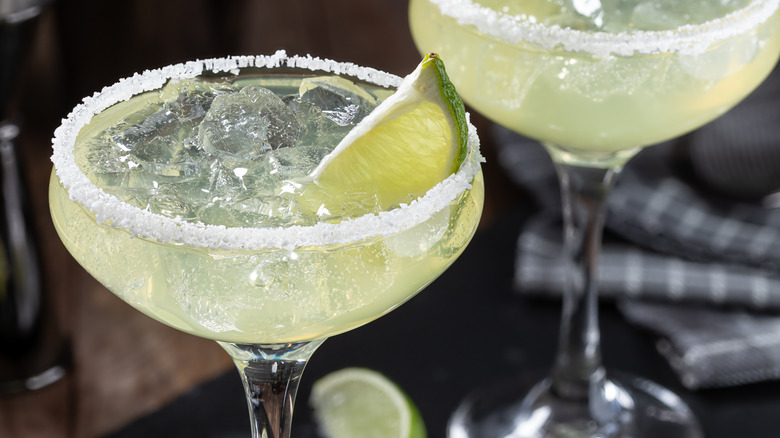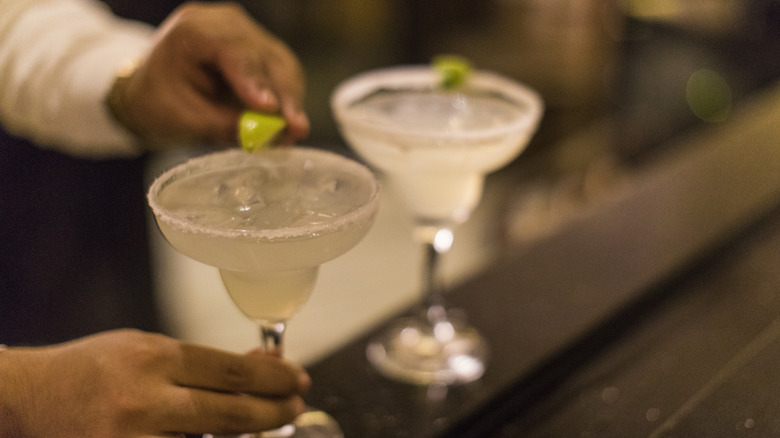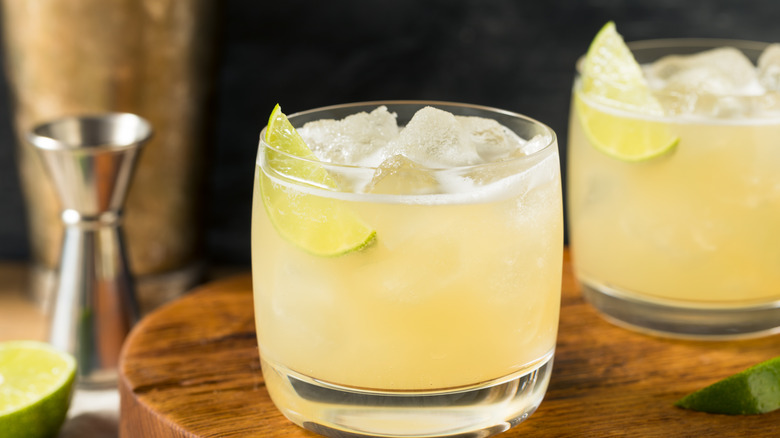The Margarita's Origin Story Is Missing Some Pieces
There's no doubt about the margarita's popularity. In recent years, this tasty salt-rimmed assemblage of tequila, orange-flavored liqueur (Grand Marnier, Cointreau, triple sec, or the like), and lime has been hailed as the world's best-loved cocktail. However, plenty of doubt surrounds the margarita's origin story. Numerous claims have been put forth for the beloved sweet and sour sipper, although none have been conclusively proven.
A compelling case can be made based on the circumstantial evidence. It will probably never be known with any degree of certainty just who was the first hero mixologist to put these ingredients together in such pleasing proportions, but it likely happened in Mexico. Of course, that makes sense since that's where tequila, the margarita's base ingredient, is made.
Most margarita origin stories take place in Mexico, with Baja California named in many of the most credible claims — including the first. That's right. The first mention of the margarita (at least by name) occurred in a newspaper article published by The Press Democrat in Santa Rosa, California, in 1953. Ensenada, one of Baja California's most popular travel destinations, was identified as where the new cocktail was first encountered. Given the drink's long history as a vacation favorite, many subsequent margarita origin stories have also involved Mexican travel destinations popular with American tourists.
Baja California figures in several origin stories
The first reference places the birth of the margarita in Baja California, as do several other plausible origin stories. Perhaps the most oft-repeated account is one linking the cocktail to Hussong's Cantina, a legendary saloon that has been open in Ensenada since 1892. As the story goes, the drink was created by barman Don Carlos Orozco in 1941. The occasion was a visit by the German ambassador to Mexico and his daughter. Her name? Margarita Henkel.
Another famous origin story attributes the cocktail's invention to Danny Herrera, owner of Rancho La Gloria, located between Rosarito and Tijuana in Baja California. In this case, the tourist was Marjorie King, a showgirl who claimed to be allergic to every liquor except one. You guessed it — tequila. Herrera says he named the drink after her in the late 1940s, using the closest Spanish equivalent to Marjorie.
These two stories, in particular, have received solid support. When Danny Herrera died in 1992, an obituary in the Los Angeles Times referred to him, without qualification, as the creator of the iconic cocktail, even though a Los Angeles-based bartender named Johnny Durlesser has also been put forth as a possible inventor. Hussong's claim, meanwhile, has been backed up by the Ensenada Historical Society. However, no incontrovertible evidence has been presented for either claim.
Tracing the likely evolution of the margarita
Was the margarita named for a real person? Possibly. But there is another more logical explanation for the cocktail's invention. Most historians believe the margarita evolved from an earlier drink called the tequila daisy. The daisy is a family of sour-style cocktails that originated in the 19th century. The first known example was the whiskey daisy. But over the years, various other liquors, such as brandy and gin, were used with standard daisy recipe ingredients like orange liqueur, citrus juice, and soda water.
First referenced in the Moville Mail in July 1936, the tequila daisy was a later addition to the family. The Moville Mail was an Iowa newspaper, but the drink was mentioned in a travel article about another destination. Yes, one in Baja California — Tijuana, to be exact. This seems to fit with later stories about the drink's beginnings. Prohibition was likely an inciting factor in the evolution of the now-beloved cocktail. Baja California cities like Tijuana and Ensenada became prime drinking destinations for Californians when alcohol became illegal in the U.S. in 1920. Another factor bears mentioning, too. When Mexicans and Americans drank side-by-side in Prohibition-Era bars in Baja California, they likely ordered drinks in their native languages. And what is the Spanish word for daisy? That's right. It's margarita.



